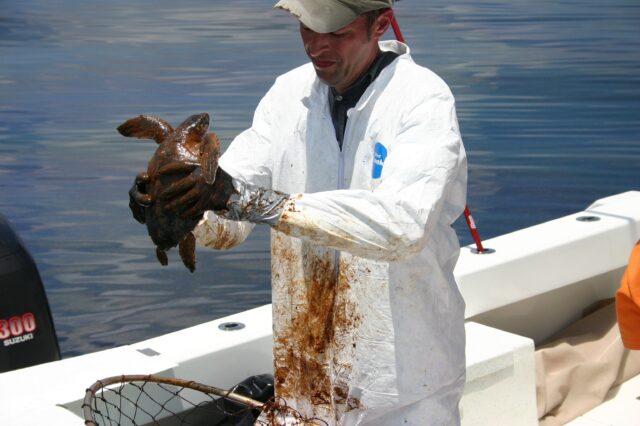UF veterinary pathologist studying animals affected by oil spill

When an unprecedented cold snap in January caused two years’ worth of turtle strandings in only 10 days, UF clinical assistant professor Brian Stacy helped lead federal efforts to treat and relocate large numbers of turtles back into the wild. Three months later, the Deepwater Horizon oil spill thrust Stacy, a veterinarian working under an agreement with the National Oceanic and Atmospheric Administration’s National Marine Fisheries’ Service Office of Protected Resources, once again into crisis-management mode.
Dr. Brian Stacy cleans an oiled Kemp’s ridley turtle. (Courtesy of NOAA and Georgia Department of Natural Resources.)
“It’s like the cold stun protracted out over months, with no end in sight,” said Stacy, a board-certified veterinary pathologist who has worked examining living and dead sea turtles offshore in Venice, La. — a hub for many of the clean-up operations — within miles of the Deepwater Horizon wreck, and in Gulfport, Miss., where he performed 67 sea turtle necropsies at the Institute for Marine Mammal Studies.
Working at his side has been Jennifer Muller, a biological scientist who assists in conducting necropsies, handling live animals, and documenting evidence.
“My technician and I have worked consistent 18-hour days under hot field conditions, away from home for weeks at a time, living in temporary housing,” said Stacy, speaking in Gainesville after three weeks of fieldwork. “It’s hard work, to say the least, and I’ve been going at it for more than 60 days now.”
Although the common assumption might be that all sea turtles collected after the spill have died because of oil-related causes, Stacy found that more than half of the turtles that have been examined had ocean-floor sediment in their lungs or airways, indicating that they may have died from drowning after being caught in fishing nets. His preliminary findings were reported June 25 in The New York Times, although additional test results are pending.
On June 25, approximately 300 dead turtles from Florida, Alabama, Mississippi and Louisiana arrived at UF for necropsy in various stages of decomposition. Each turtle was logged in and placed inside a 20-foot storage freezer and the chain of custody was transferred to Stacy, in compliance with federal requirements.
Biological samples from the turtles are sent to laboratories designated by the Unified Command — which consists of federal and state government as well as private entities, including BP.
Dr. Brian Stacy cleans an oiled Kemp’s ridley turtle. (Courtesy of NOAA and Georgia Department of Natural Resources.)
“We are fortunate to have Dr. Stacy working as the primary sea turtle vet for NOAA’s marine animal health team,” said Helen Golde, the deputy director of NOAA’s Office of Protected Resources. “He is invaluable as we work through the Unified Command to respond to the Deepwater Horizon spill. Dr. Stacy’s experience in veterinary medicine and sea turtle pathology are unique and he is leading these critical elements of the overall effort.”
For Stacy, the two most distressing things so far have been experiencing the scale of the spill and seeing animals completely mired in hot oil.
“It’s a terrible way for an animal to die,” Stacy said.
There has been a bit of good news, though. Of approximately 60 sea turtles Stacy and his team were able to rescue, most survived.
“All are still in rehabilitation facilities and eventually will be released,” Stacy said. “We’re still in the learning process of determining how the oil will affect them, both in this key interval and longer term. There is a lot of ongoing effort to identify release sites that are biologically appropriate and that are out of harm’s way.”
As for Stacy, who knows his work will continue indefinitely, he is doing his best to stay focused on the job at hand.
“What keeps me going is helping animals, and the fact that the attention this situation is getting right now is an opportunity to shed light on some of the important concerns in the Gulf of Mexico for sea turtles,” Stacy said. “You just try to find the hours here and there when you can compartmentalize and put it out of your mind. My wife and family are very supportive, and that is critical.”
About the author
